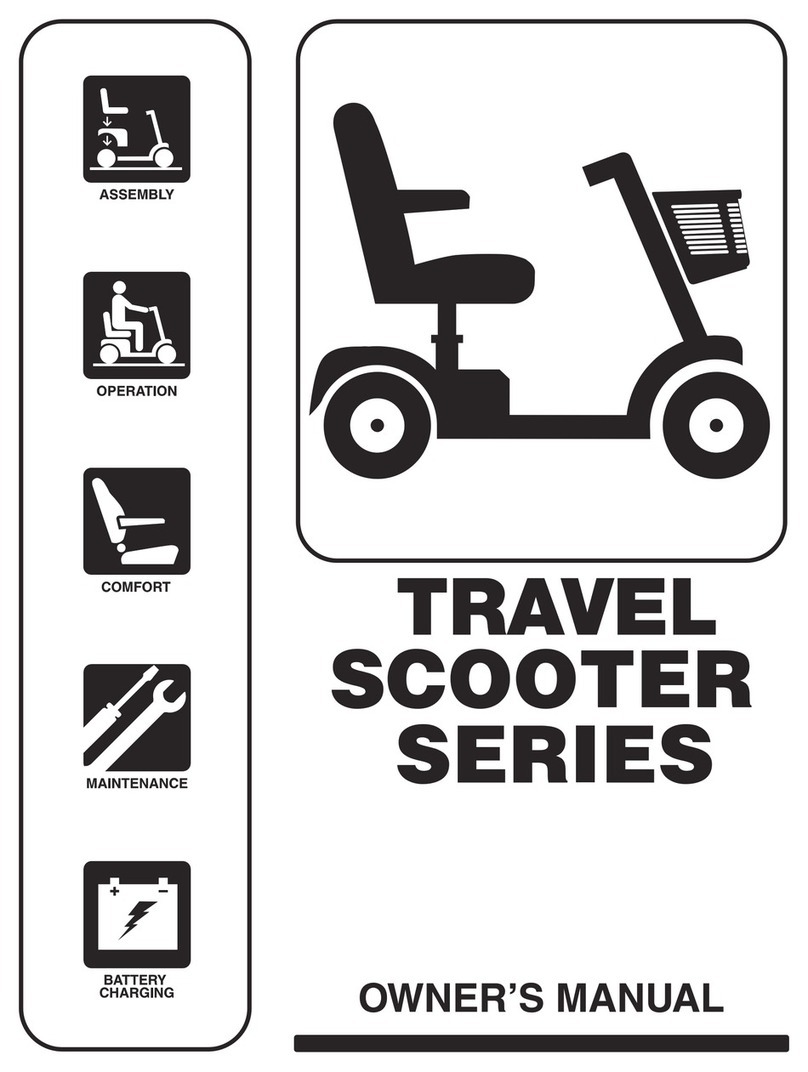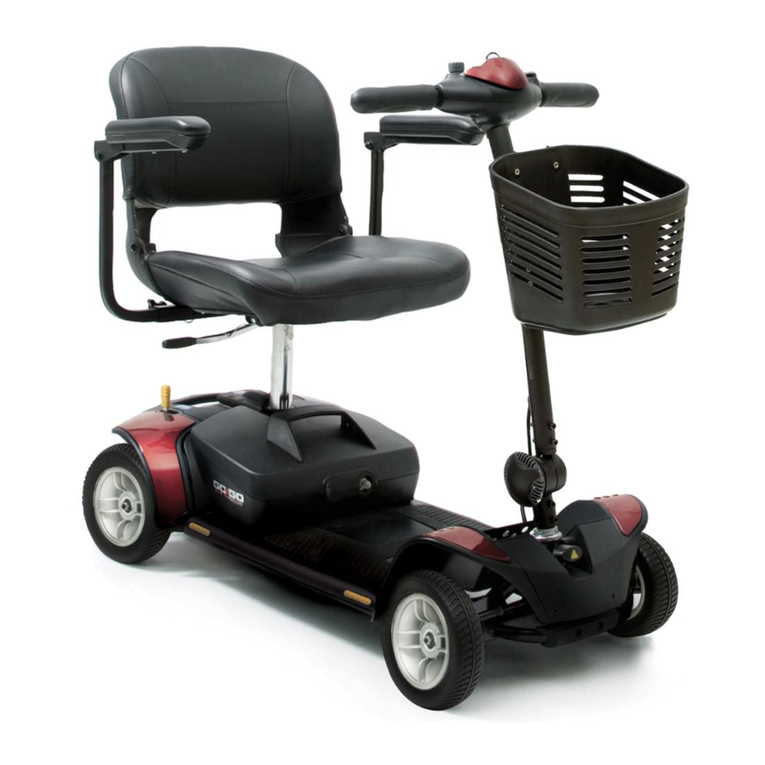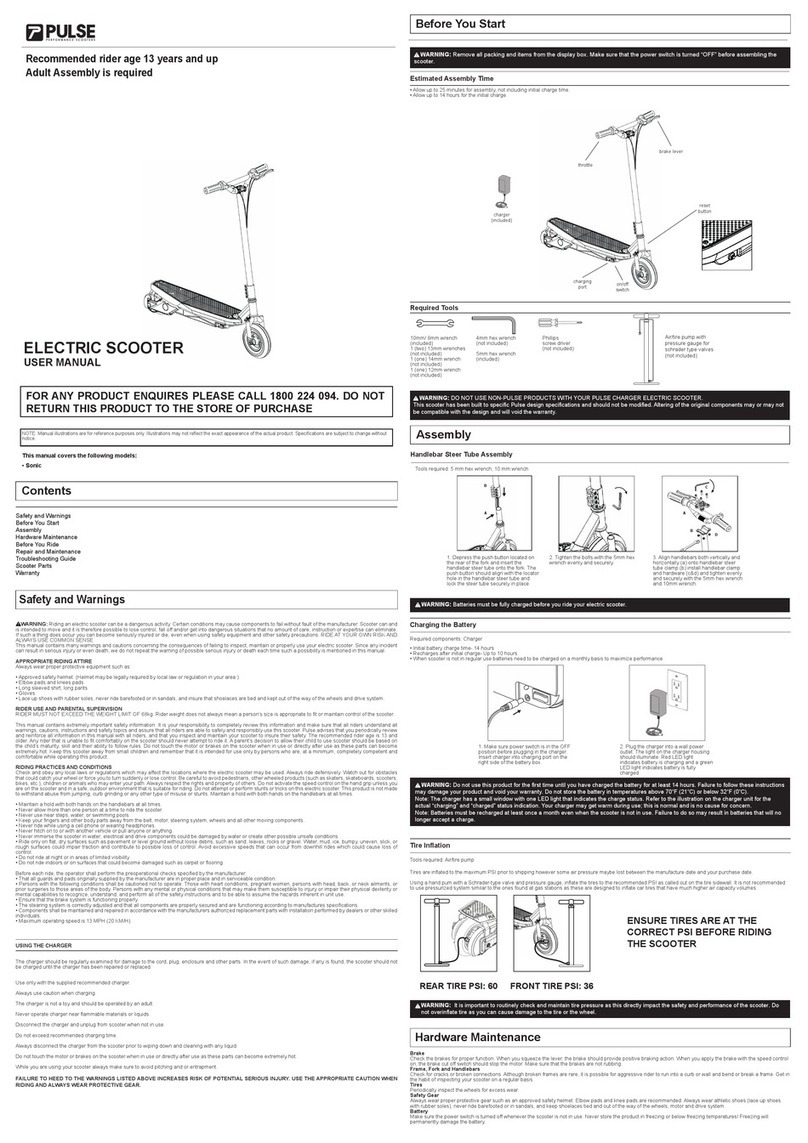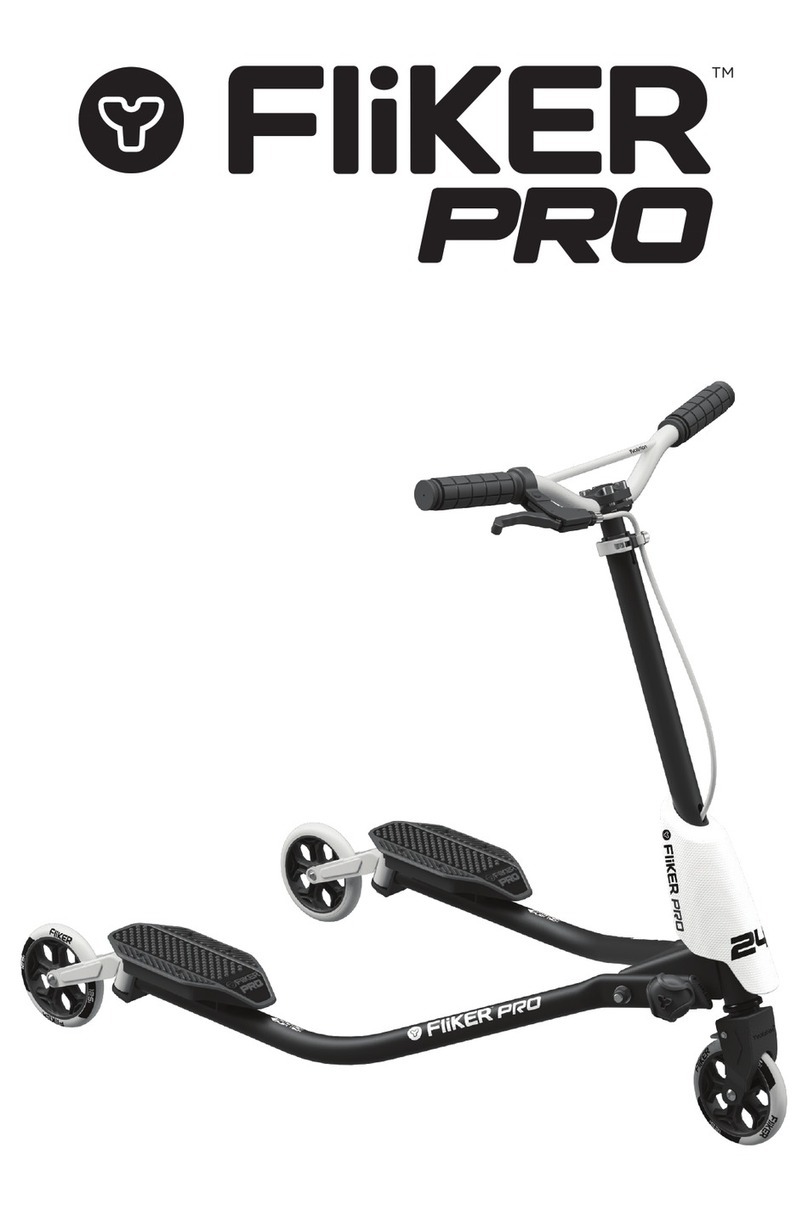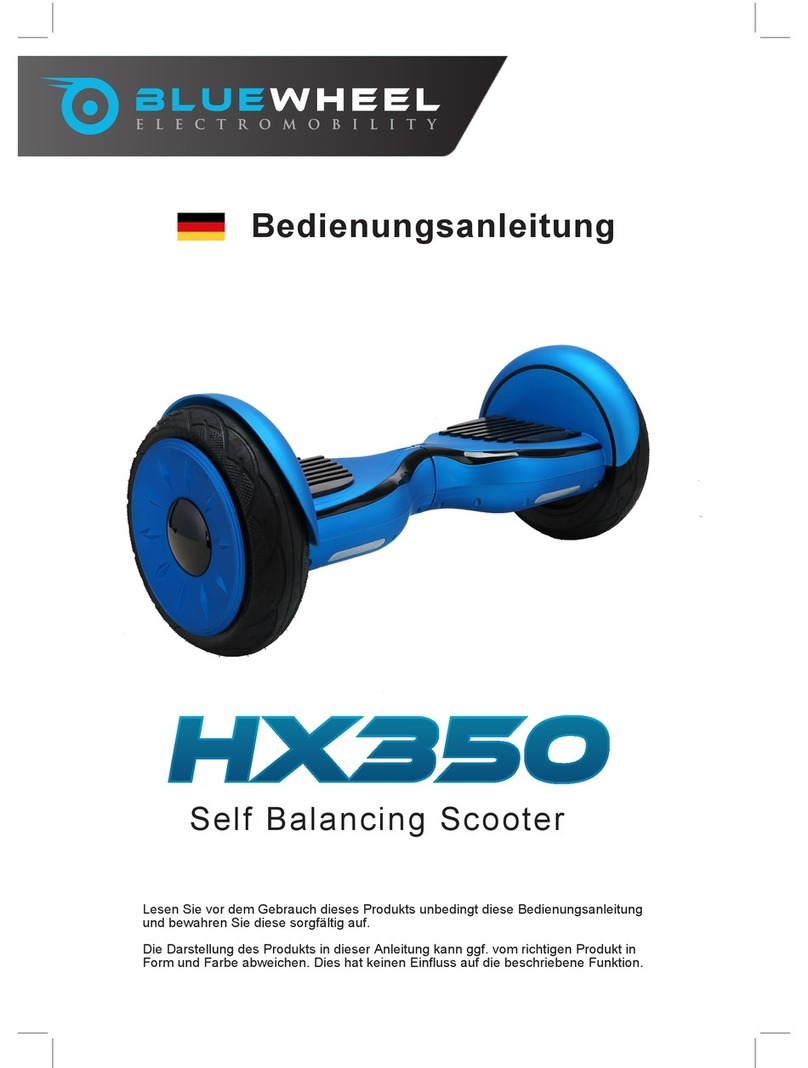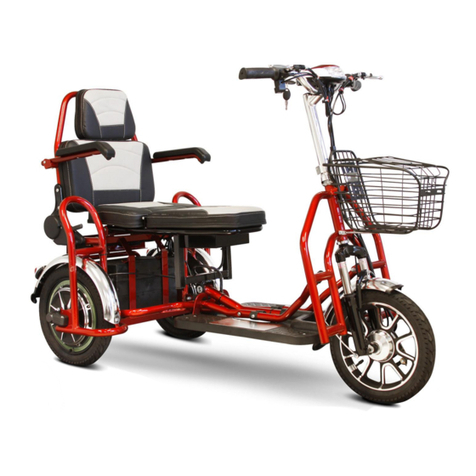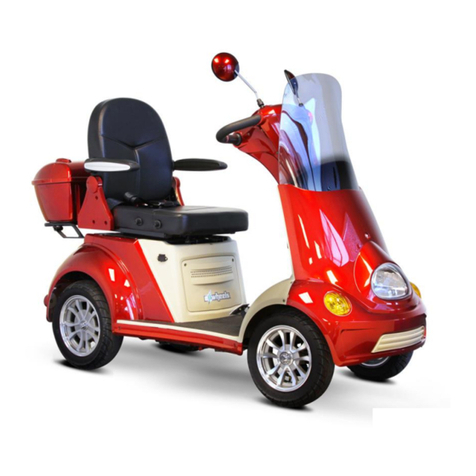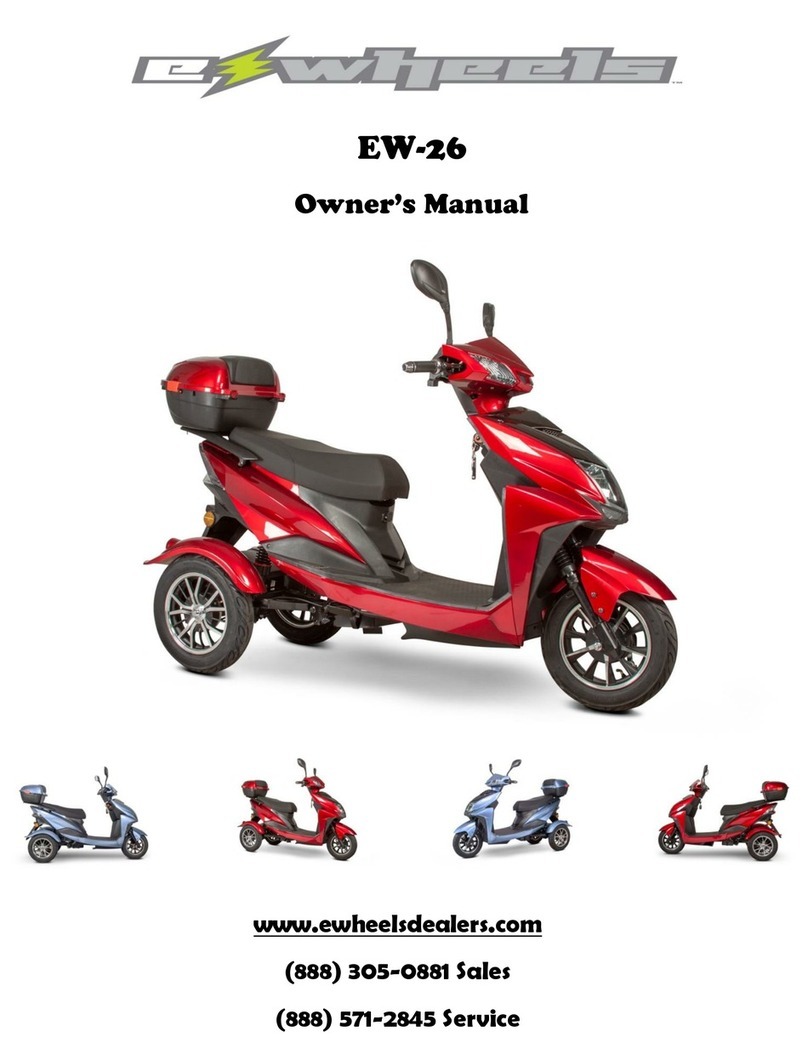Patterson ST4D User manual

Strider Instruction Booklet
ST4E
ST4D
Issue 3 January 2013
MOBILITY SCOOTER
MOBILITY SCOOTER
MOBILITY SCOOTER

Instruction BookletST#4
TABLE OF CONTENTS
INTRODUCTION
IMPORTANT PRECAUTIONS
ELECTROMAGNETIC INTERFERENCE AND WARNINGS
IDENTIFICATION OF PARTS
CHARGING THE BATTERIES
DISASSEMBLING YOUR SCOOTER
ASSEMBLING YOUR SCOOTER
CARE AND MAINTENANCE
OPERATING YOUR SCOOTER
TROUBLESHOOTING
TECHNICAL SPECIFICATIONS
INSPECTION CHECKS
--------------------------------------------------------1
----------------------------------------2
----3
----------------------------------------5
---------------------------------------9
-----------------------------10
----------------------------------11
----------------------------------------12
------------------------------------14
------------------------------------------------16
------------------------------------18
----------------------------------------------19

ST#4 Instruction Booklet
INTRODUCTION
1
Thank you and congratulation on purchasing your new Patterson Medical Ltd. Mobility
Scooter. It is designed to provide you with transportation ability indoors and outdoors.
We pride ourselves on providing safe and comfortable products. Our goal is to ensure
your complete satisfaction. We sincerely hope you enjoy your new Mobility Scooter.
Information of European Representative :
EMERGO EUROPE
Molenstraat 15
2513 BH, The Hague
The Netherlands
If you have any question, you can contact :
or your local dealer:
If you are visually impaired, this document can be viewed in PDF format at
www.pattersonmedical.com or alternatively is available on request in large text.
The vehicle has been successfully safety-tested to German and international standards.
It was also successfully tested to EN60529 IPX4 for splash water insensitivity, and
is therefore ideally suitable for typical central European weather conditions.
We estimate a life expectancy of five years for this product, provided it is used in
strict accordance with the intended use as set out in this document and all maintenance
and service requirements are met. The estimated life expectancy can be exceeded
if the product is carefully used and properly maintained, and provided technical and
scientific advances do not result in technical limitations. The life expectancy can also
be considerably reduced by extreme or incorrect usage.
The fact that we estimate a life expectancy for this product does not constitute an
additional warranty.
General risks
This symbol warns you of general hazards!
ɀAlways follow the instructions to avoid injury to the user or damage to the product.
READ WELL BEFORE OPERATION!
This symbol advises you to read information carefully.
This symbol identifies general information which is intended to simplify working
with your product and which refers to special functions.
Important symbols in this manual & Product Markings
Please read and observe all warning and instruction provided in owner's manual
before you operate with various convenient function of this scooter. Also, please
retain this booklet for future reference.
Life expectancy

ST#4 Instruction Booklet
IMPORTANT PRECAUTIONS
2
Risk of injury from hot surfaces!
•This scooter is designed for single person use only at any one time.
•Maximum load is 136 kgs.
•Turn key off before getting on or off.
•Always drive carefully and be aware of others using the same area.
•Always use pedestrian crossings wherever possible.
Take extreme care when crossing roads.
•Do not drive on slope exceeding 10 degree, and take extreme care when turning on
slope.
•Do not use full power when turning to sharp corner.
•Take great care and drive in low speed when backing up, riding downhill or on uneven
surface, and climbing curb.
•Scooter may not operate well in high humidity.
•If you are caught in rain, it is handy to carry a scooter canopy. It offers complete
protection for your and scooter.
•Never put scooter in neutral when staying on slopes.
•Follow traffic laws when riding outside.
Do not leave the mobility device in direct sunlight for prolonged periods. Metal parts
and surfaces such as the seat and armrests can become very hot.
The scooter ST#4E /4D conforms to the following standards :
•requirements for resistance to ignition in accordance with ISO 7176-16
•seat materials used on this product conform to EN1021 parts 1 and 2.
NOTE:
The control system is programmed with standard values in the works. Your Patterson
Medical dealer can carry out programming tailored to fit your requirements.

ST#4 Instruction Booklet
2.Medium-range mobile transceivers, such as those used in police cars, fire trucks,
ambulances, and taxis. These usually have the antenna mounted on the outside of
the vehicle; and
3.Long-range transmitters and transceivers such as commercial broadcast transmitters
(radio and TV broadcast antenna towers) and amateur (HAM) radios
Other types of hand-held devices, such as cordless phones, laptop computers,
AM/FM radios, TV sets, CD players, and cassette players, and small appliances,
such as electric shavers and hair dryers, so far as. we know, are not likely
to cause EMI problems to your motorized scooter.
ELECTROMAGNETIC INTERFERENCE
AND WARNINGS
3
CAUTION: It is very important that you read this information regarding the possible
effects of Electromagnetic Interference on your motorized scooter.
Powered wheelchairs and motorized scooters may be susceptible to electromagnetic
interference (EMI), which is interfering electromagnetic energy (EM) emitted from sources
such a radio stations, TV stations, amateur radio (HAM) transmitters, two-way radios, and
cellular phones. The interference (from radio wave sources) can cause the motorized
scooter to release its brakes, move by itself, or move in unintended directions. It can also
permanently damage the motorized scooter control system. The intensity of the interfering
EM energy can be measured in volts per meter (V/m). Each motorized scooter can resist
EMI up to a certain intensity. This is called its "immunity level." The higher the immunity
level, the greater the protection. At this time, current technology is capable of achieving
at least a 20 V/m immunity level, which would provide useful protection from the more
common sources of radiated EMI. The immunity level of this motorized scooter model
is not known.
There are a number of sources of relatively intense electromagnetic fields in the everyday
environment. Some of these sources are obvious and easy to avoid. Others are not
apparent and exposure is unavoidable. However, we believe that by following the
warnings Listed below, your risk to EMI will be minimized.
Some cellular telephones and similar devices transmit signals while
they are ON, even when not being used
The sources of radiated EMI can be broadly classified into three types :
1.Hand-held portable transceivers (transmitters-receivers) with the antenna mounted directly
on the transmitting unit. Examples include: citizens band (CB) radios, "walkie talkie,"
security, fire, and police transceivers, cellular telephones, and other personal communication
devices

ST#4 Instruction Booklet
4
Because EM energy rapidly becomes more intense as one moves closer to the transmitting
antenna (source), the EM fields from hand-held radio wave sources (transceivers) are of
special concern. It is possible to unintentionally bring high levels of EM energy very close
to the motorized scooter control system while using these devices. This can affect motorized
scooter movement and braking. Therefore, the warnings listed below are recommended
to prevent possible interference with the control system of the motorized scooter.
Motorized Scooter Electromagnetic Interference:
Danger of malfunction due to electromagnetic interference!
•Do not switch on or operate portable transceivers or communication devices (such as
radio transceivers or cellular phones) when the vehicle is switched on.
•Avoid getting near strong radio and television transmitters.
•In case the vehicle should be set in motion unintentionally or the brakes are released,
switch it off immediately.
•Adding electrical accessories and other components or modifying the vehicle in any way
can make it susceptible to electromagnetic interference. Keep in mind that there is no
sure way to determine the effect such modifications will have on the overall immunity
of the electronic system.
•Report all occurrences of unintentional movement of the vehicle, or release of the electric
brakes to the manufacturer.
Warnings:
This electric vehicle was successfully tested in accordance with International standards
as to its compliance with Electromagnetic Interference (EMI) regulations. However,
electromagnetic fields, such as those generated by radio and television transmitters, and
cellular phones can influence the functions of electric vehicles. Also, the electronics used
in our vehicles can generate a low level of electromagnetic interference, which however
will remain within the tolerance permitted by law. For these reasons we ask you to please
observe the following precautions:
Safety information on electromagnetic interference
1.20 volts per meter (V/m) is a generally achievable and useful immunity level against
EMI (as of May 1994). The higher the level, the greater the protection.
2.The immunity level of this product is at least 20/Vm.
Important Information:

ST#4 Instruction Booklet
Battery Gauge
Horn
Left&Right
Turn Signal
Speed Dial Knob
Warning
Light Hi/Lo Speed
Switch (Option)
Power/Self-Diagnostic Warning Light
Thumb
Lever
Tiller Angle
Adjustment
Seat Sliding
Slide Lever
Swivel Seat
With Head Rest
Adjustable
Armrest
Seat Rotation
Lever
11" Front and Rear Wheels
Basket
Head Light
Figure 1 - ST-4E / ST-4D Front View
Figure 2 - ST-4E / ST-4D Control Panel
Figure 3 -
ST-4E / ST-4D
Rear View
IDENTIFICATION OF PARTS
5
Before attempting to drive this scooter on your own, it is important that you familiarize
yourself with the controls, and how to operate.
Armrest Width
Adjustment
Thumbscrews
Rear Turn
Signals
(Option) Anti-tip Wheels
N/D
Lever
Reflectors
Reflector
The position of the labels
on the product
Identification of charger
socket
1
Euro Rep information
2
Identification label
3
Model name label
4
logo label
5
Free wheel label
6
1
2 3
2 3
6
4
5
6

ST#4 Instruction Booklet
6
FUNCTION OF PARTS:
Figure 4
Figure 4
Figure 5
Figure 5
Do not set the speed at maximum when operating the scooter. Adjust the
speed at maximum when inclining a slope, and adjust to minimum speed
when declining a slope.
Check battery's capacity before driving, and charging batteries when at low
power.
MAIN SWITCH (A)
1.By turning the key clockwise to ON to turn on the power
2.By turning the key anticlockwise to OFF to turn off the power.
3.By turning the key to to turn on the head light.
Speed Dial Knob (B)
The Rabbit means fast and Turtle is slow.
By turning this you control total speed transferred to thumb controls.
Horn Button (C)
Pressing down the button to sound buzzer.
Battery Gauge (D)
There is a meter shows batteries capacity status.
When battery gauge's light trends to F, it indicates sufficient power capacity.
When battery gauge's light trends to E, it indicates insufficient power capacity.
TOP CONTROL PANEL (Hi/Lo)
High & Low Speed Switch allows speed to be changed from the normal maximum 12.8 kmph
to half for pavement use.
Panel Control
Pressing down at left side as left turn signal.
Pressing down at right side as right turn signal.
Pressing down as warning light.
(A)
(C)
(B)
(D)
(D1)
Figure 6
Figure 6
(Hi/Lo)

ST#4 Instruction Booklet
Figure 7
Figure 7
Figure 8
Figure 8
Figure 9
Figure 9
(G)
(F)
(a)
(H)
(E)
7
Thumb Lever
Pulling right thumb lever (E) moves scooter forward. Pulling left thumb lever (F) moves
the scooter backward. (This can be reversed if required by local dealer.) Releasing both,
engages automatic brake. These are also your accelerator. The further you depress them,
the faster you go. (Subject to the position of the Rabbit/Turtle control).
Tiller Angle Adjustment
Pulling the tiller adjustment (G) downwards to adjust tiller's angle and release to lock at
a desired comfortable position.
Seat Swivel Adjustment
Setting at a comfortable angle by pulling lever (H) upwards to rotate seat (a) left and right..
Seat fore-aft Adjustment
Setting at a comfortable position by lifting lever (l) upwards to adjust the seat (a).
(a)
(I)

ST#4 Instruction Booklet
Figure 10
Figure 10
(J)
(K)
Armrest width Adjustment Thumbscrews
1.Loosen the two thumbscrews (K) to adjust arm width tighten again to lock in at desired
position.
2.Adjust the attached screw (J)'s height, to control armrest's angle.
Figure 11
Figure 11
(L)
8
Anti-tip wheels
Helps keep scooter from tipping over.
Free-Wheeling Lever (L)
When lever is in N (Neutral) position, scooter can be moved manually without power.
When lever is in D (Drive) position, scooter can be driven. Normal position is D.
Your scooter should be delivered fully configured for your use;
There are a range of components and adjustments available on the ST#4E /4D.
For further information about these you should contact your Patterson Medical
authorised dealer.

ST#4 Instruction Booklet
Keep in mind these rules:
•Fully charge batteries at least once a month, or more if you use scooter regularly.
Charge after each trip exceeding 3 kilometers.
•If storing your scooter for some time (1 month or more), make sure that batteries
are fully charged, and on returning, charge them again before using scooter.
•Batteries will only give maximum performance after scooter has been used, and
batteries have been recharged up to 10 times. A bit like breaking in a new car.
Batteries must be charged before using the scooter for the first time and should be
recharged after each day use. You will need the scooter and the battery charger.
1.Insert battery charger cord into the charger connector on the charger output. Refer to
above figure for correct position
2.Plug the other end of the battery charger cable into a standard electrical outlet.
3.Turn the power on. Normally, The LED (Power) Light will turn on when electric current
passes.
4.Charging starts. During charging, LED (Charge) will indicate orange light, when it turns
to green light, that means well-charged.
5.LED indication
•LED(POWER) - GREEN LIGHT ON : Power On.
•LED(CHARGE) - ORANGE LIGHT ON : Charging / GREEN LIGHT ON : Fully Charged
6.Charger Trouble Shooting
(A)If LED (POWER) light is off
•Check the input voltage (115V/230V) is the same as you adjust.
•If light is still off, please check and repair the battery charger.
(B)If LED (CHARGE) light is off
•Check to see clips connection is correct.
•If the battery is fully charged, the LED (CHARGE) light will be off.
•If light is still off, the battery may be defective.
(C)If ORANGE light can turn to GREEN
•The battery can not be charged. Please check and recover it.
(D)If ORANGE light turns to GREEN immediately
•Check to see the battery is fully charged, if not, The battery may be defective
Check and recover it.
Each country may supply different
charger. The charging procedure
may be different from below.
If you require more details, please
contact your authorized dealer.
Be sure the scooter key is in the
OFF position
The time needed to recharge will vary depending on the depletion of the
batteries. Charging for longer than necessary will not harm the batteries.
They can not be overcharged.
9
CHARGING THE BATTERIES
Figure 12
Figure 12

ST#4 Instruction Booklet
(H)
(a)
(P)
(Q) (S) (T)
(R)
(b)
(b)
(b)
(b)
Figure 13
Figure 13
Figure 14
Figure 14
Figure 15
Figure 15
Figure 16
Figure 16
Figure 17
Figure 17
Figure 18
Figure 18
10
DISASSEMBLING YOUR SCOOTER
Disassembling Basket
By lifting the basket (O) upwards.
Disassembling Seat
By lifting lever (H) and seat (a) upward.
Rear Compartment Cover
Open the Compartment Cover (P) according to
arrow's direction.
Disassembling Batteries
Disconnect front&reat section wire harness (Q) , then tear off battery straps (R) and battery
terminals (S) to remove the batteries (b). (Figure.16 & 17)
Disassembling Front and Rear Frame
By pulling the frame hook comp (T) backwards to disconnect front and rear frame. (Figure.18)
Be careful when removing batteries, as batteries are heavy.
Do not contact battery terminal with any metals to avoid danger.
-+
(O)

ST#4 Instruction Booklet
11
ASSEMBLING YOUR SCOOTER
To assemble scooter, you can repeat disassembly directions in reverse. Abbreviated
directions are given below. Refer to Figures on pages 10 to locate parts.
1.Use the tiller adjustment to move tiller up and out of the way.
2.Place front basket.
3.Place battery pack in battery compartment.
4.Place seat on seat post and tighten seat locker knob.

ST#4 Instruction Booklet
Cleaning Your Scooter:
If your scooter is dirty, use a damp or lightly soapy cloth to wipe it down. Do not use
running water to wash or rinse scooter in order to protect electrical parts. Polish with
an automotive liquid polish.
Maintaining Your Scooter:
All maintenance and repair of scooter should be done by an authorized dealer.
The following areas required periodic inspection:
•Tyre pressure (Tyre pressure = 2.8 bar / 280 kilopascals)
•All electrical connections are firmly attached
Please Contact your approved Patterson Medical Dealer for further information
regarding Servicing of the scooter, as it is recommended that only authorized
Paterson Medical Dealer carry out this work.
Please contact your Patterson Medical dealer as it is recommended that only
authorized Patterson dealer carry out any such work.
•Open-ended spanner, 12 mm
•Open spanner, 17 mm.
•Rubber hammer
Storing Your Scooter:
Between uses, your scooter is best stored in a dry location.
Remark :
Obstacle height approx. 5cm (Figure.19)
Feasible groove width approx. 17cm, scooter must go straight line to across the groove. (Figure.20)
Requirements for end user service tools required
12
CARE AND MAINTENANCE
Figure 19
Figure 19
Figure 20
Figure 20

ST#4 Instruction Booklet
13
Danger of accident and loss of guarantee if maintenance is insufficient!
•For reasons of safety and in order to avoid accidents which result from unnoticed
wear, it is important that this electric mobility product undergoes an inspection
once every year under normal operating conditions (see inspection plan contained
in service instructions).
•Under difficult operating conditions such as daily travel on steep slopes, or in the
case of use in medical care cases with frequently changing wheelchair users, it
would be expedient to carry out intermediate checks on the brakes, accessories
and running gear.
•If the mobility product is to be operated on public roads, the vehicle driver is
responsible for ensuring that it is in an operationally reliable condition. Inadequate
or neglected care and maintenance of the mobility product will result in a limitation
of the manufacturer's liability.
Safety information with regard to care and maintenance

ST#4 Instruction Booklet
OPERATING YOUR SCOOTER
14
You could make the following adjustments to increase your comfort when driving.
•adjust seat position.
•adjust armrest width to comfortable position.
•adjust tiller's angle.
This scooter has automatic braking system. Release the thumb lever
and brake will stop scooter.
1.Before operating your scooter, check the following:
•free-wheeling lever in D
•speed dial knob is at turtle picture.
2.Sit on scooter and turn on key, Battery Gauge meter should be indicate at F.
The Self-Diagnostic Warning Light should not be blinking.
3.When your hands rest comfortably on handlebars, the thumb levers should be
within easy
reach. The right lever moves scooter forward, the left one moves it backward. When you
release both levers, scooter will stop.
4.Steer scooter by turning tiller toward the way you want to go.
5.Practice driving where there are is No obstacle. Start at the slowest speed and drive
forward and backward; make some turns. As you get more comfortable, you can increase
speed by turning speed dial toward picture of rabbit.
6.
If Battery Gauge indicates E, you should plan to recharge batteries very soon.
7.If scooter stops, locate the circuit breaker on top of battery pack. Push it and try
driving again.
8.When you are finished riding, turn off the key before getting off.
9.If you are finished riding for the day, immediately recharge batteries.
See CHARGING THE BATTERIES, page 9.

ST#4 Instruction Booklet
In unlikely event of a panel display error, you need to re-set the display
system by cycling the on/off main switch. The display circuitry is independent
of the motor control system. A display console error does not affect scooter
speed control.
15
Keep in mind these rules:
•Release thumb levers and allow scooter to stop completely before changing from
forward to reverse, or reverse to forward.
•When turning to corner, swing front wheels widely, so back wheels will turn more
tightly.
•Use scooter only where it is safe for waiting.
•Drive in low speeds when reversing, riding downhill, over ramp or curb, or on
uneven surface, downhill, ramps, curbs, or uneven surfaces.
Other Operating Information:
Hill climbing: You may need to use a higher speed. Turn to lower speed before
going downhill.
Down slopes: proceed with downward slopes slowly, and set speed control in
proximity of turtle. The closer speed control is set toward turtle, the slower scooter
travels. However, this scooter will not self accelerate down hills due to the automatic
braking, taking effect should you attempt to drive too fast.
Kerb climbing: Approach slowly from right angles to curb. A slight angle is
permissible with a 4-wheel scooter. Do not attempt greater than a 5cm curb.
If Self-Diagnostic Warning Light starts to blink, identify problem from chart on
page 16 and take action.
If the scooter breaks down and must be moved, get off scooter, engage
Free-Wheeling Lever to N, push scooter slowly to a safe location, and push lever
back to D.

ST#4 Instruction Booklet
16
TROUBLESHOOTING
Here are some suggestions about solving problems you may have with your scooter. There
is a Self-Diagnostic Warning Light on the Control Panel. To check the Self-Diagnostic
Warning Light, turn on the key and count the number of blinks on the Warning Light.
The Low Battery Fault Flash code, described above, is a requirement of
various safety standards.
The scooter will output a visible and audible low battery warning if the
battery voltage drops below 90% of its cut-off voltage. The warning will
be two short flashes, and will take priority over all other flash codes in
the system.
Flash Description Meaning
1
Battery Low
The batteries are running low.
•Recharge the batteries.
Low Battery Fault
The batteries have run out of charge.
•Recharge the batteries.
•Check the battery and associated connections and wiring.
2
3
High Battery Fault
Battery voltage is too high. This may occur if overcharged
&/or travelling down a long slope.
•If travelling down a slope, reduce your speed to minimize
the amount of regenerative charging.
4
Current Limit
Time-out or
Controller too hot
The motor has been exceeding its maximum current rating
for too long.
•The scooter may have stalled. Turn the controller off,
leave for a few minutes and turn back on again.
•The motor may be faulty. Check the motor and
associated connections and wiring.
5
Park Brake Fault
Either a park brake release switch is active or the park
brake is faulty.
•Check the park brake and associated connections and
wiring.
•Ensure any associated switches are in their correct
positions.
6
Drive Inhibit
Either a Stop function is active or a Charger Inhibit or
OONAPU condition has occurred.
•Release the Stop condition (seat raised etc.)
•Disconnect the Battery Charger
•Ensure the throttle is in neutral when turning the
controller on.
•The Throttle may require re-calibration.
7
Speed Pot Fault
The throttle, speed limit pot, SRW or their associated wiring
may be faulty.
•Check the throttle and speed pot and associated
connections and wiring.
8
Motor Voltage Fault
The motor or its associated wiring is faulty.
•Check the motor and associated connections and wiring.

ST#4 Instruction Booklet
17
9
Other error
The controller may have an internal fault.
•Check all connections and wiring.
Other Problems
Low tyre pressure: inflate to (2.8 bar / 280 kilopascals)
During charging, light on charger does not change to green: Contact your authorized dealer.
Scooter will not move when key is turned on:
1.Check Power Reserve Indicator on control panel, it should be lighting in green,
yellow, and red zones.
2.Check Self-Diagnostic Warning Light, it should be steady. If it is flashing, see
chart above for problem identification.
3.Check all electrical connections to be sure they are tight.
4.If none of above correct problem, contact your authorized dealer.

ST#4 Instruction Booklet
*Subject to change without notice.
Overall Length
Overall Width
Overall Height
Wheels: Front
Wheels: Rear
Weight w/ Batteries
Max. Speed
Weight Capacity
Ground Clearance
Grade Climbable
Curb Climbing
Turning Radius
Suspension
Brake
Seat Type
Seat Width
Motor Size
Battery Size
Battery Weight
Travel Range
Battery Charger
Electronics
Reversing Width
1200 mm / 47.2"
620 mm / 24.4"
1190 mm / 47"
290 mm / 11"
290 mm / 11"
87 kg / 191 lbs
8 kmph / 5 mph
136 kg / 300 lbs
60 mm / 2.4"
10 degree
50 mm / 2"
1540 mm / 60.6"
N/A
Electro-Mechanical
455 mm / 18"
500W 3100 r.p.m
(2) 24V. 36Ah
23 kg / 51 lbs
34 km / 21 Miles
5A Off Board
1200 mm / 47.2"
628 mm / 24.7"
1190 mm / 47"
290 mm / 11"
290 mm / 11"
96.4 kg / 212.4 lbs
12 kmph / 7.5 mph
136 kg / 300 lbs
60 mm / 2.4"
10 degree
50 mm / 2"
1540 mm / 60.6"
Front & Rear
Electro-Mechanical
455 mm / 18"
700W 4500 r.p.m
(2) 24V. 50Ah
31.3 kg / 69 lbs
42.5 km / 26.4 Miles
5A Off Board
SPECIFICATIONS ST4E ST4D
On/Off Key Switch, Battery Level Indicator,
Speed Control Knob
620 mm
Premium Upholstery Mid-Back w/ Headrest
Swivel Seat-Sliding Adjustment
TECHNICAL SPECIFICATIONS
18
This manual suits for next models
1
Table of contents
Popular Scooter manuals by other brands
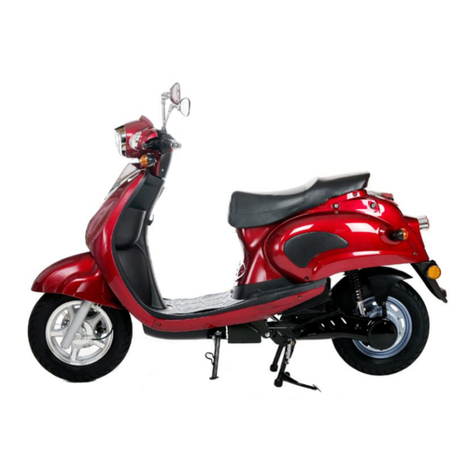
Xtreme
Xtreme XM-3100 Operation and maintenance instructions

G-Force
G-Force S5 user manual

SUPER 73
SUPER 73 R Series OWNER HANDBOOK ASSEMBLY & MAINTENANCE

Bulls
Bulls Lacuba Evo 8 Translation of the original operating instructions
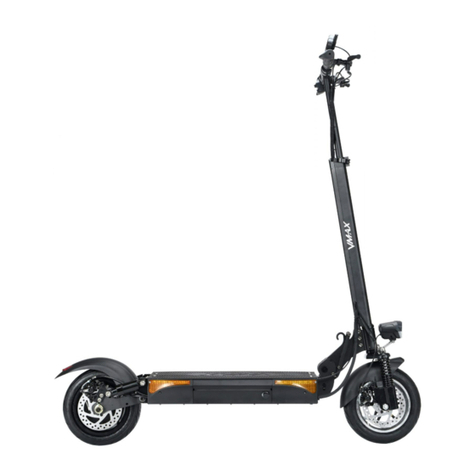
V-max
V-max VMAX R25 PERFORMANCE user manual
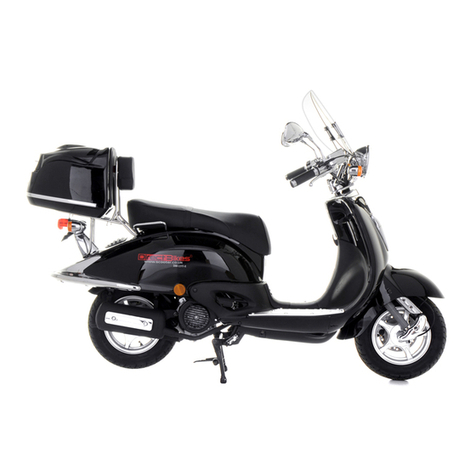
DirectBikes
DirectBikes DB125T-E manual
